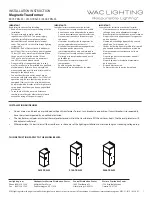
GENERAL
DESCRIPTION
TSM 20-275D rev 0: Jul 1, 2010
1
DTT250M
DTT250M
– 250W Digital Television Transmitter
INTRODUCTION
This
manual
describes
the
LARCAN
model
DTT250M
VHF
Digital
Television
Transmitter.
LARCAN
all
‐
solid
‐
state
250W
VHF
transmitters
are
designed
to
operate
conservatively
at
250W
average
DTV
power
with
superb
performance,
reliability
and
operating
economy.
The
transmitter
and
exciter
or
translator
chassis
are
packaged
in
a
single
19"
cabinet.
The
simplicity
of
design,
the
deployment
of
all
modular
and
other
subassemblies,
and
the
use
of
standard
readily
available
components,
enhances
serviceability.
Important
transmitter
parameters
are
monitored,
and
can
be
displayed
on
the
meter
built
into
the
amplifier.
Additionally,
all
meter
readings
are
made
available
as
DC
signals
for
telemetry
by
remote
control
systems.
The
DTT250M,
like
all
other
LARCAN
transmitting
equipment,
is
suitable
for
automatic
or
remote
‐
control
operation.
AMPLIFIER
CHAIN
The
RF
output
of
the
exciter
is
fed
to
a
conservatively
designed
broadband
solid
‐
state
amplifier.
This
amplifier
requires
no
tuning
or
adjustment
within
its
band
of
operation.
Simplicity
of
operation,
reduced
maintenance
costs
and
increased
reliability
are
a
few
of
the
major
benefits
derived
from
this
modular
amplifier.
This
module
is
operated
well
below
its
maximum
ratings.
The
amplifier
chain
consists
of
three
stages
of
amplification.
The
preamplifier
stage
is
a
high
gain,
broadband,
thin
‐
film
integrated
circuit
amplifier
operating
class
A.
The
IPA
stage
consists
of
a
pair
of
push
‐
pull
FETs
in
a
single
case,
operating
in
class
AB
as
a
linear
amplifier.
This
amplifier
uses
the
identical
dual
FET
device
that
is
used
by
the
PA
module.
The
final
amplifier
stage
consists
of
six
push
‐
pull
FET
amplifiers
that
operate
in
class
AB,
in
three
groups
of
two
in
quadrature,
and
are
combined
in
quadrature
and
then
in
a
3
‐
way
combiner.
The
amplifier
module
is
rated
for
250
watts
average
ATSC
output.
The
module
is
provided
with
soft
‐
start,
VSWR
protection,
and
a
monitor
port.
The
amplifier
output
is
fed
to
the
bandpass
filter
and
the
directional
coupler,
which
provides
a
small
sample
of
forward
and
reflected
output
power
for
AGC
and
VSWR
supervisory
functions.
The
transmitter
output
then
passes
to
the
antenna
system.


































